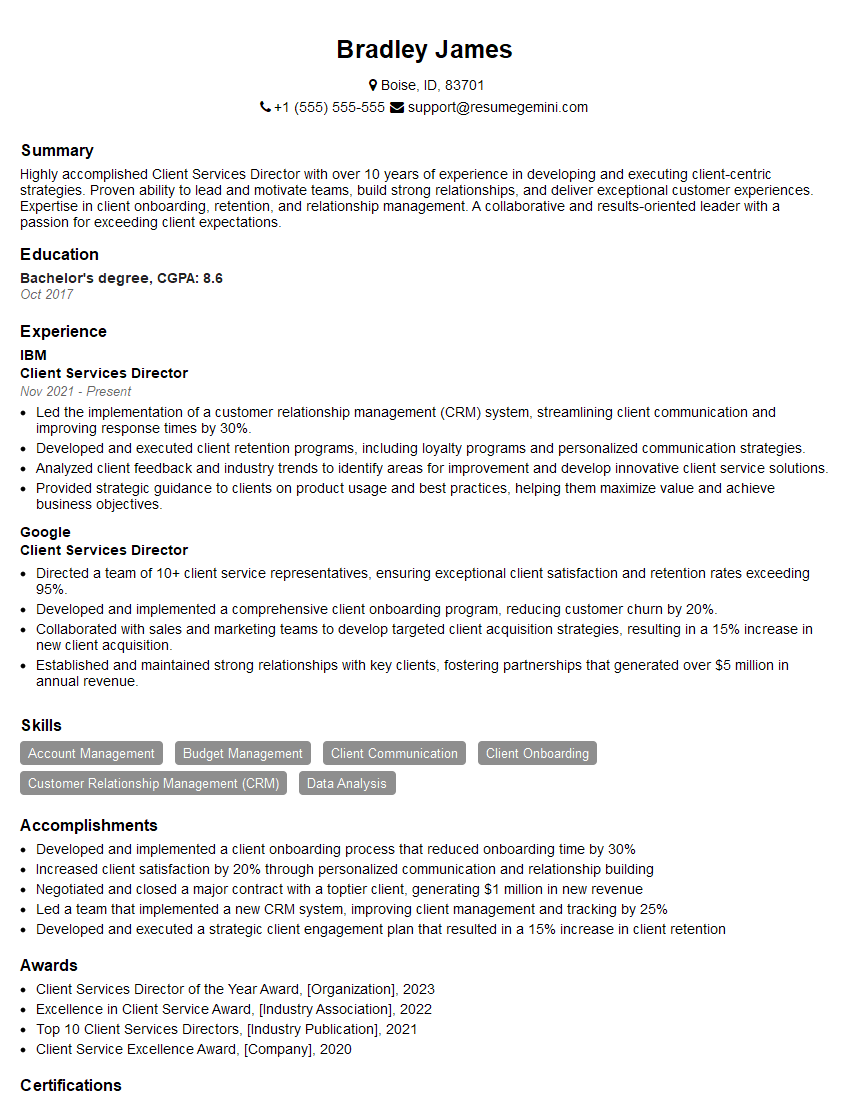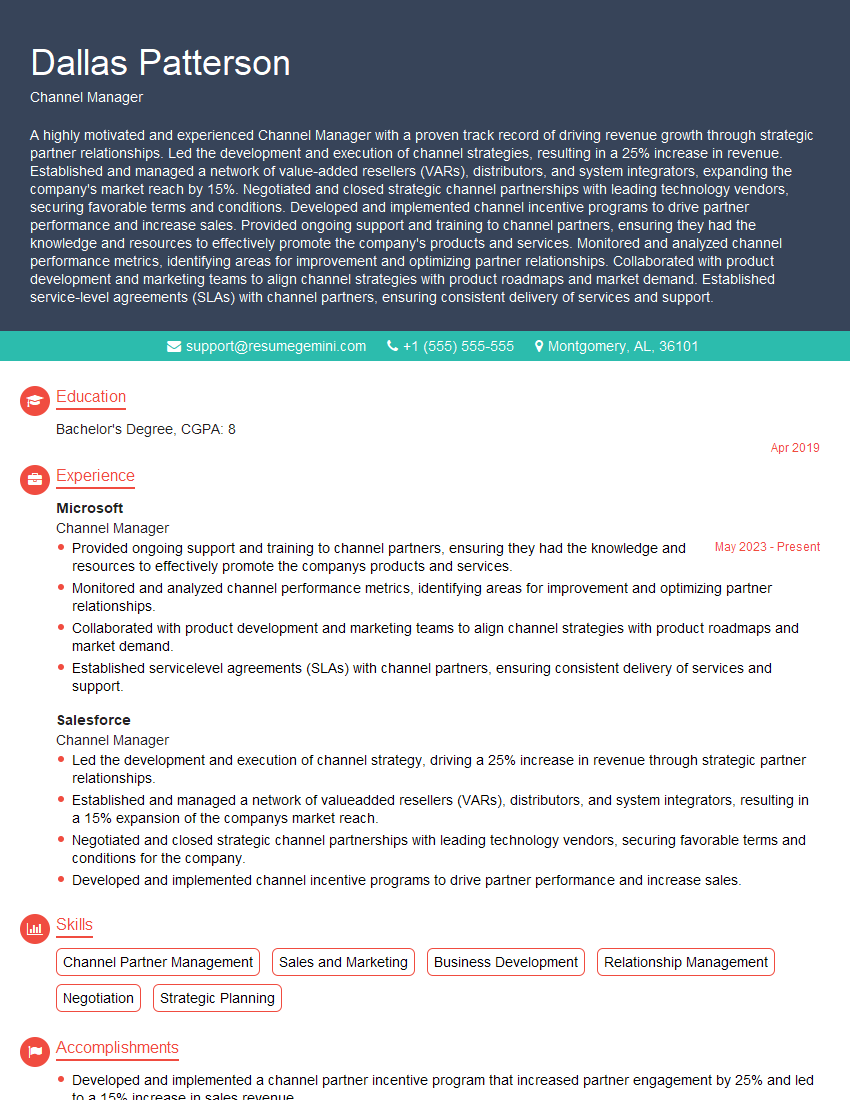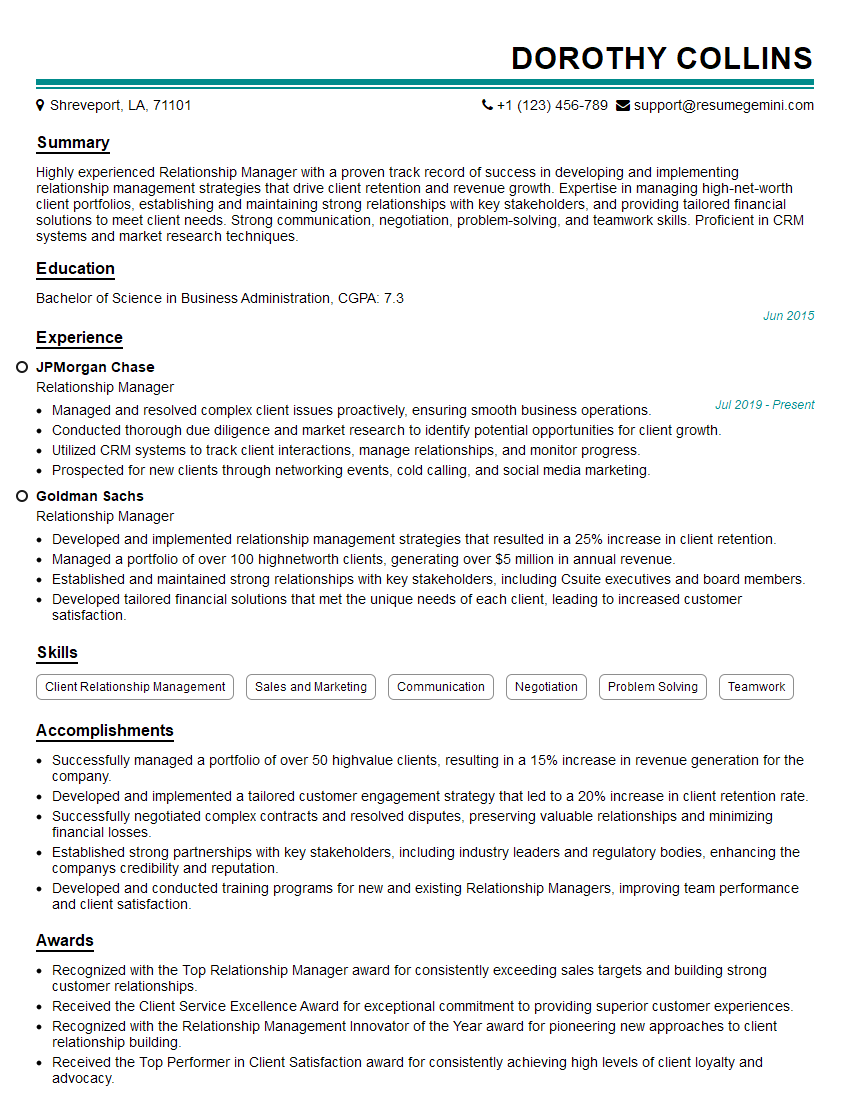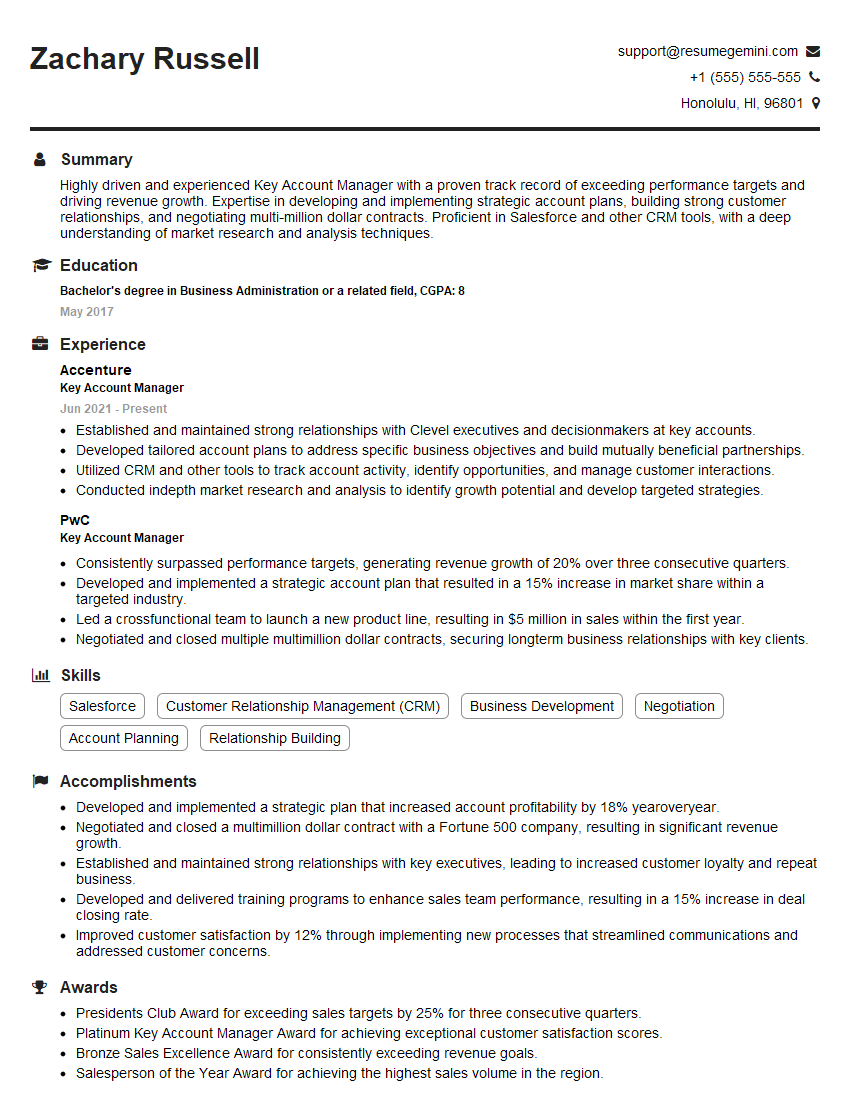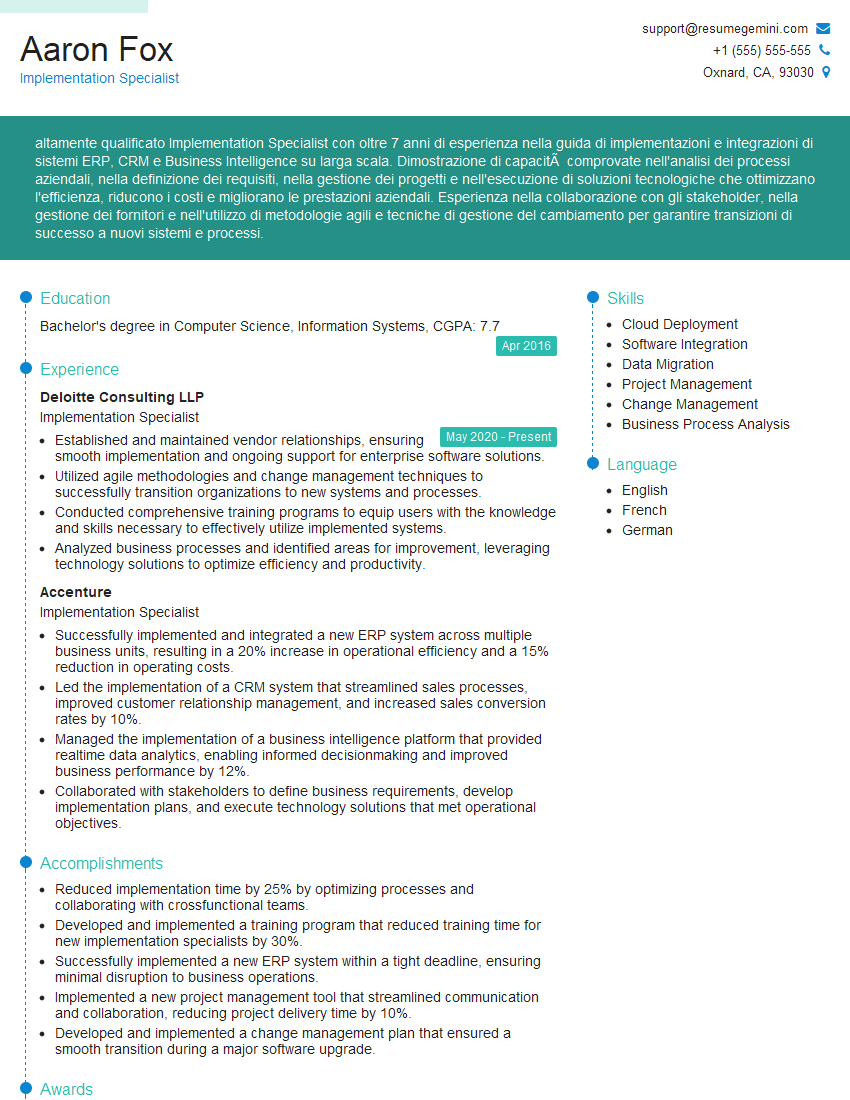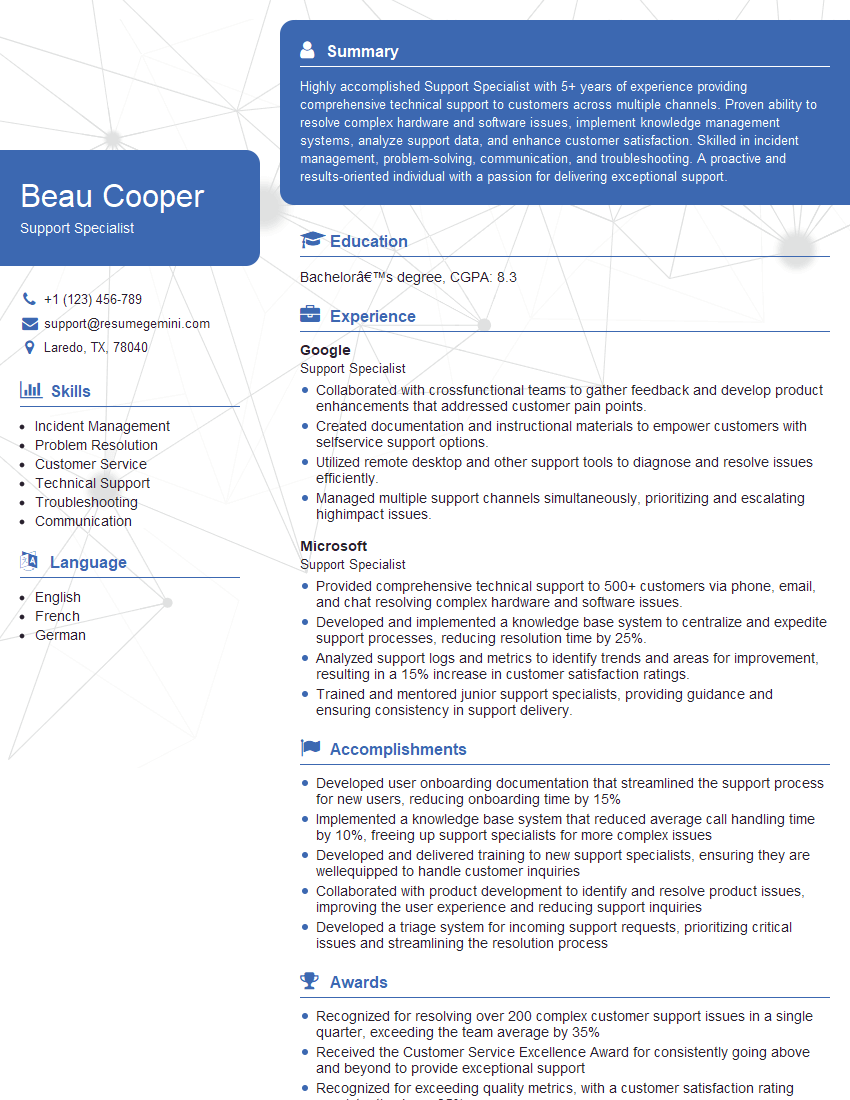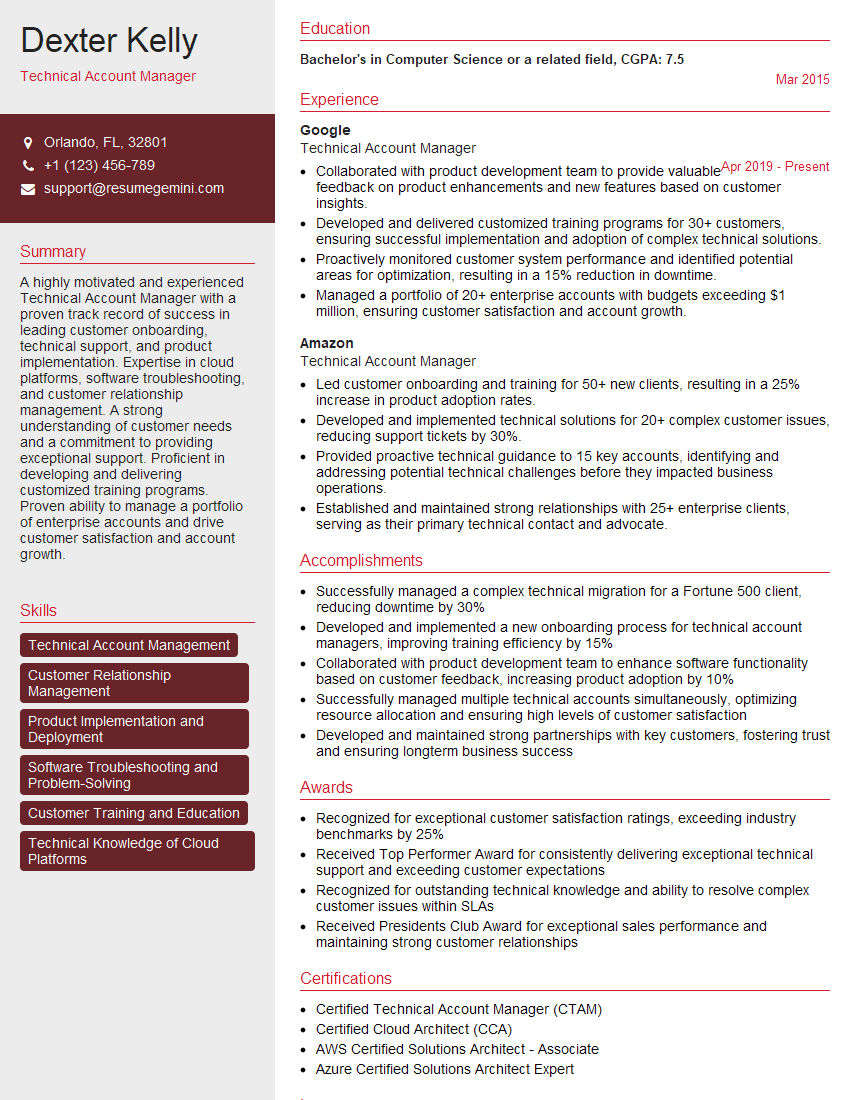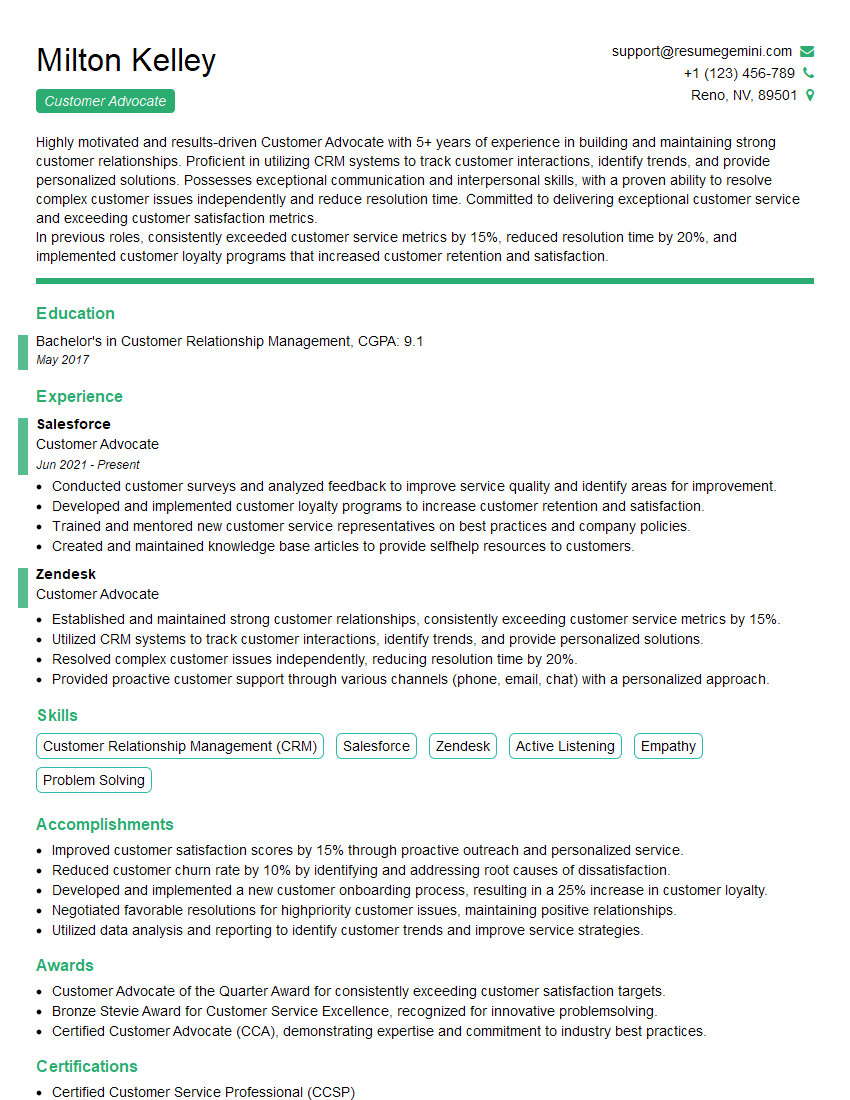Feeling uncertain about what to expect in your upcoming interview? We’ve got you covered! This blog highlights the most important Ability to identify and meet customer needs interview questions and provides actionable advice to help you stand out as the ideal candidate. Let’s pave the way for your success.
Questions Asked in Ability to identify and meet customer needs Interview
Q 1. Describe a time you identified an unmet customer need.
Identifying unmet customer needs is crucial for business success. It involves actively listening, observing, and analyzing customer interactions to pinpoint areas where current offerings fall short or where new opportunities exist. I once worked on a project where we were developing a new mobile banking app. While conducting user testing, we noticed a significant number of users struggled with the navigation, particularly older adults who were less familiar with touchscreen technology. This revealed an unmet need for a more intuitive and accessible interface for users of varying technical abilities. We didn’t just assume this was a minority issue – the data showed a significant portion of our target demographic would be frustrated by this design flaw. That feedback directly led to redesigning the navigation system, making it larger, simpler, and more easily understandable, ultimately resulting in higher user satisfaction and adoption rates.
Q 2. How do you prioritize competing customer needs?
Prioritizing competing customer needs often involves a multi-faceted approach. I usually utilize a framework that considers several factors: Urgency, Impact, and Feasibility. Urgency refers to how quickly a need must be addressed. Impact assesses the effect on the business or customers if the need isn’t met. Feasibility explores the resources, time, and effort required to address the need. I typically use a simple matrix to visualize this. Needs with high urgency, high impact, and high feasibility are prioritized first. Those with low urgency, low impact, and low feasibility are often addressed later or deferred. For example, if we had a critical bug affecting a core feature (high urgency, high impact, high feasibility), that would take precedence over a request for a minor aesthetic change (low urgency, low impact, high feasibility).
Q 3. Explain your process for gathering customer feedback.
My process for gathering customer feedback is multifaceted and incorporates both proactive and reactive methods. Proactively, I use surveys, both online and offline, to capture a broad range of opinions. We also conduct regular focus groups to delve deeper into specific issues. Reactively, I monitor customer service interactions closely – email, phone calls, and social media – to identify recurring complaints or suggestions. Analyzing website analytics, such as bounce rates and heatmaps, provides valuable insights into user behavior and pain points. The key is to utilize multiple channels to obtain a comprehensive and balanced picture of customer sentiment.
Q 4. How do you translate customer feedback into actionable insights?
Translating customer feedback into actionable insights involves several steps. First, I organize and categorize the feedback, identifying common themes and patterns. This might involve using qualitative data analysis techniques to identify recurring words or phrases related to pain points or positive experiences. Next, I quantify the feedback whenever possible, determining the frequency and severity of specific issues. For example, if 50% of survey respondents cite difficulty with a particular feature, it strongly suggests the need for improvement. Finally, I develop clear recommendations based on the analysis, proposing specific solutions or changes to products, services, or processes. This often includes quantifiable goals, like reducing customer service calls by 15% or improving user engagement on a feature by 20%.
Q 5. Describe a situation where you had to adapt your approach to meet a customer’s specific needs.
In one instance, a large client required a customized solution that deviated significantly from our standard offering. They needed a specific integration with their legacy system, a task that presented significant technical challenges. Instead of rigidly adhering to our usual approach, we adopted an agile methodology. We worked closely with the client, iteratively developing and testing the integration, ensuring each step aligned with their specific needs. This involved frequent communication, flexible planning, and a willingness to adapt our processes throughout the project. This resulted in a strong client relationship and successful delivery, demonstrating our commitment to meeting unique customer requirements.
Q 6. How do you handle conflicting customer requests?
Handling conflicting customer requests requires careful diplomacy and prioritization. I begin by understanding the underlying needs of each customer. Sometimes, seemingly conflicting requests stem from different interpretations of the same problem. Open communication is key; I directly engage with the customers involved, explaining the constraints and seeking mutually acceptable solutions. Where compromises are necessary, I explain the rationale behind my decisions transparently, ensuring everyone feels heard and understood. When no mutually agreeable solution can be found, I prioritize requests based on the criteria outlined earlier: urgency, impact, and feasibility.
Q 7. How do you measure the success of meeting customer needs?
Measuring the success of meeting customer needs involves tracking various key performance indicators (KPIs). These might include customer satisfaction scores (CSAT), Net Promoter Score (NPS), customer churn rate, and resolution times for customer service inquiries. Improvements in these metrics directly indicate increased customer satisfaction and loyalty. Beyond numbers, qualitative feedback – such as positive reviews or testimonials – provides valuable insights into the overall impact of the changes implemented. A holistic approach that combines quantitative and qualitative data provides the most accurate and informative picture of success.
Q 8. How do you proactively identify potential customer needs before they are voiced?
Proactively identifying customer needs before they’re voiced involves a combination of keen observation, data analysis, and empathetic understanding. It’s about anticipating their future requirements based on current trends, past interactions, and market insights.
For example, imagine I’m working for a software company. By analyzing usage patterns of our existing product, I might notice a significant increase in users requesting a specific feature via support tickets or forum posts. Even if it’s not explicitly demanded by many yet, this signals a growing, unmet need. I could then proactively propose developing that feature, getting ahead of the curve and potentially gaining a competitive advantage.
Another example: If I notice a competitor launching a new product with a particular feature, I’d investigate whether it addresses a gap in our own offerings and if it’s something our customers might also want. This involves market research, analyzing competitor strategies, and understanding our own customer base.
Q 9. What tools or techniques do you use to understand customer needs?
Understanding customer needs requires a multi-faceted approach. I use a range of tools and techniques, starting with direct customer interaction.
- Surveys and Feedback Forms: These allow for gathering quantitative and qualitative data directly from customers about their satisfaction, pain points, and desired features.
- Focus Groups and Interviews: These provide in-depth insights by facilitating detailed discussions with a select group of customers. It’s great for uncovering underlying needs and motivations.
- Social Listening: Monitoring social media, online forums, and review sites helps me understand what customers are saying about our products and services, both positive and negative.
- Data Analytics: Analyzing website usage data, sales figures, and CRM information provides valuable insights into customer behavior and preferences.
- A/B Testing: Experimenting with different website designs or product features allows me to test hypotheses about customer preferences and optimize solutions.
Combining these techniques provides a comprehensive understanding that goes beyond surface-level feedback.
Q 10. Describe your experience using customer relationship management (CRM) systems.
My experience with CRM systems is extensive. I’ve used several platforms, including Salesforce and HubSpot, to manage customer interactions, track sales opportunities, and analyze customer data. I’m proficient in using CRMs to segment customers based on various attributes (demographics, purchase history, engagement levels), allowing for targeted communication and personalized experiences.
For example, I’ve used Salesforce to create automated email campaigns for new customers, providing them with onboarding resources and support. I’ve also used the data within the CRM to identify customers at risk of churning and proactively reach out to address their concerns. CRMs are powerful tools for not only organizing information but for proactively improving customer relationships and predicting future needs.
Q 11. How do you build rapport with customers?
Building rapport with customers is crucial for effectively addressing their needs. I start by actively listening and demonstrating genuine empathy. It’s about understanding their perspective and making them feel heard and valued.
I use techniques such as mirroring body language subtly, using their name frequently, and asking open-ended questions to encourage them to share their thoughts and feelings. Showing genuine interest in their situation, beyond just the immediate problem, creates a strong foundation for trust. For instance, asking a customer about their business goals beyond their current technical issue helps establish a longer-term connection and demonstrates that I’m invested in their overall success.
Q 12. How do you manage customer expectations?
Managing customer expectations involves setting realistic timelines, clearly communicating the capabilities and limitations of the product or service, and being transparent about any potential delays or challenges.
I always aim to over-deliver where possible, exceeding expectations whenever feasible. If a delay is unavoidable, I communicate proactively, explaining the reasons for the delay and offering alternative solutions or updates. This transparency builds trust and prevents misunderstandings that could lead to disappointment. For instance, if I’m working on a software project and realize a feature will be delayed, I will immediately inform the client, provide a revised timeline, and perhaps offer a compensatory service to make up for the inconvenience.
Q 13. How do you handle difficult or upset customers?
Handling difficult or upset customers requires patience, empathy, and a calm demeanor. I start by actively listening to their concerns without interruption, validating their feelings, and acknowledging their frustration. I use phrases like “I understand your frustration,” or “I can see why you’re upset.”
Next, I focus on finding a solution. I might offer a sincere apology, even if I wasn’t directly responsible for the issue, as it acknowledges their feelings and demonstrates accountability. I then work collaboratively with the customer to find a mutually agreeable resolution. Even if the solution isn’t perfect, a sincere effort to understand and accommodate the customer’s needs goes a long way.
Q 14. What is your approach to resolving customer complaints?
My approach to resolving customer complaints is systematic and focuses on finding a lasting solution. I follow a structured process:
- Listen and Empathize: Fully understand the customer’s complaint and acknowledge their feelings.
- Investigate the Issue: Gather all necessary information to determine the root cause of the problem.
- Propose a Solution: Offer a realistic and timely solution that addresses the customer’s needs.
- Implement the Solution: Take action to resolve the problem efficiently and effectively.
- Follow Up: Contact the customer to ensure they are satisfied with the resolution and to prevent future occurrences.
Throughout this process, I maintain clear communication, keeping the customer informed about my progress. This transparency builds trust and demonstrates a commitment to resolving their issue effectively. This systematic approach not only resolves individual problems but helps identify patterns that could lead to process improvements and prevent similar issues in the future.
Q 15. Describe a time you had to go above and beyond to meet a customer’s needs.
Going above and beyond for a customer often involves anticipating their needs and proactively addressing potential issues before they arise. It’s about exceeding expectations and demonstrating a genuine commitment to their satisfaction.
For example, I once worked with a client who was launching a new product. Their deadline was incredibly tight, and they were experiencing significant technical difficulties with their website integration. While my primary responsibility was data analysis, I saw their distress and recognized the potential damage a delayed launch could cause. I volunteered to assist their development team, leveraging my analytical skills to help identify and troubleshoot the root cause of the integration problems. This involved late nights and collaboration with engineers, but ultimately, we resolved the issue and launched the product on time. The client was immensely grateful, and it strengthened our business relationship significantly.
Career Expert Tips:
- Ace those interviews! Prepare effectively by reviewing the Top 50 Most Common Interview Questions on ResumeGemini.
- Navigate your job search with confidence! Explore a wide range of Career Tips on ResumeGemini. Learn about common challenges and recommendations to overcome them.
- Craft the perfect resume! Master the Art of Resume Writing with ResumeGemini’s guide. Showcase your unique qualifications and achievements effectively.
- Don’t miss out on holiday savings! Build your dream resume with ResumeGemini’s ATS optimized templates.
Q 16. How do you balance customer needs with business objectives?
Balancing customer needs with business objectives requires a strategic approach that prioritizes long-term value creation. It’s not about choosing one over the other but rather finding the sweet spot where both are mutually beneficial. This involves understanding the business’s overall goals and then aligning customer solutions with those objectives.
For instance, while offering personalized service might seem ideal for each customer, it might not be economically feasible if it requires an impractical investment of time and resources. Instead, we might segment our customers to provide targeted solutions that cater to the majority while still offering bespoke services to high-value clients. This ensures customer satisfaction while staying within the constraints of the business plan. This balanced approach helps foster customer loyalty and enhances the company’s bottom line.
Q 17. How do you stay up-to-date on customer trends and needs?
Staying current on customer trends and needs is crucial for maintaining a competitive edge. I employ a multi-pronged approach involving continuous learning and data analysis.
- Active Listening & Feedback Collection: I actively seek out customer feedback through surveys, focus groups, and direct interactions. This provides real-time insights into their evolving needs and pain points.
- Industry Research: I regularly read industry publications, attend conferences, and follow thought leaders to stay abreast of emerging trends. This helps me anticipate future needs and adapt our strategies proactively.
- Data Analysis: I utilize various data analytics tools to monitor customer behavior, purchase patterns, and website traffic. This data helps identify emerging patterns and shifts in customer preferences.
- Social Media Monitoring: Keeping track of conversations and sentiments on social media platforms provides valuable qualitative data regarding customer opinions and needs.
Q 18. Describe your experience with market research techniques.
My experience with market research techniques spans both quantitative and qualitative methods. I’m proficient in conducting surveys, focus groups, and competitive analyses.
- Quantitative Methods: I’ve used statistical software like SPSS and R to analyze large datasets and identify statistically significant trends. This includes creating customer segmentation models based on demographic, behavioral, and psychographic data.
- Qualitative Methods: I’ve conducted in-depth interviews and focus groups to gain a deeper understanding of customer motivations, perceptions, and unmet needs. This involves careful analysis of transcripts and identification of recurring themes.
- Competitive Analysis: I regularly analyze competitor offerings and strategies to identify opportunities for differentiation and improvement. This involves studying competitor websites, marketing materials, and customer reviews.
Q 19. How do you use data to inform your understanding of customer needs?
Data is the cornerstone of understanding customer needs. I use various techniques to extract actionable insights.
- Customer Segmentation: I use data to segment customers based on their characteristics and behaviors. This allows me to tailor products and services to specific groups and personalize the customer experience.
- Predictive Modeling: I leverage data to predict future customer behavior, such as churn risk or product adoption. This allows us to proactively address potential problems and improve customer retention.
- A/B Testing: I use A/B testing to compare different versions of marketing materials or product features to identify what resonates most with customers. This allows us to optimize our offerings based on data-driven evidence.
- Web Analytics: I analyze website traffic and user behavior to identify pain points in the customer journey and improve website usability.
For example, by analyzing website analytics, we discovered a high bounce rate on our product pricing page. This indicated a problem with clarity or user experience. By redesigning the page and making pricing information more transparent, we significantly reduced the bounce rate and improved conversions.
Q 20. How do you collaborate with other teams to meet customer needs?
Collaborating with other teams is essential for meeting customer needs holistically. Effective communication and a shared understanding of goals are key.
I regularly collaborate with product development, marketing, sales, and customer support teams. For example, when customer feedback revealed a usability issue with our software, I worked closely with the product development team to define the problem, analyze its root cause, and prioritize a solution. Then, I collaborated with the marketing team to communicate the improvements to customers, and with customer support to ensure a smooth transition.
Utilizing project management tools and regular meetings facilitate clear communication and coordinated efforts, ensuring that all stakeholders are aligned on customer priorities and solutions.
Q 21. How do you communicate customer needs to different stakeholders?
Communicating customer needs effectively to different stakeholders requires tailoring the message to their specific roles and interests.
- Executive Summary: When communicating to senior management, I provide concise executive summaries highlighting key findings, their business impact, and proposed solutions.
- Detailed Reports: For product development or marketing teams, I provide detailed reports with data visualizations and supporting evidence.
- Visualizations: Using charts, graphs, and infographics makes complex data easily understandable for a wider audience.
- Storytelling: Framing customer needs through compelling narratives helps connect emotionally with stakeholders and highlights the human aspect of the issue.
By adopting this multi-faceted approach, I ensure that all stakeholders are informed, engaged, and motivated to address customer needs effectively.
Q 22. Describe a time you had to make a difficult decision regarding customer needs.
One challenging situation involved a client who needed a custom software solution. Their initial request was for a feature-rich system with a tight deadline and a limited budget. This created a direct conflict: meeting all three requirements was practically impossible. My decision-making process involved several steps. First, I actively listened to the client, understanding not just the what but also the why behind their requests. I then prioritized their needs based on their business impact and feasibility. We ultimately decided to deliver a core set of features by the deadline, while outlining a phased rollout for the remaining features. This transparent communication ensured the client understood the trade-offs and allowed for flexibility. Open communication and a collaborative approach prevented a potentially disastrous outcome and built strong client trust.
Q 23. How do you handle situations where customer needs are unclear or contradictory?
When customer needs are unclear or contradictory, my approach is systematic. I begin by asking clarifying questions using open-ended prompts to encourage detailed responses. For example, instead of asking ‘Do you need feature X?’, I might ask, ‘Tell me more about how you envision using the system to achieve your goals.’ This helps uncover underlying needs and motivations. I then use active listening and empathy to identify any contradictions and address them collaboratively. Sometimes creating a visual representation like a mind map can help both me and the customer to see the interplay of their different desires. If the needs remain irreconcilable, I present different options that address various aspects of their requirements, ensuring they understand the potential compromises and trade-offs involved. The goal is to find a solution that best aligns with their overall objectives, even if it means compromising on a specific aspect.
Q 24. What are some common challenges in meeting customer needs, and how have you overcome them?
Meeting customer needs presents several challenges. One common challenge is managing expectations. Customers often have unrealistic timelines or budgets. I address this by setting clear expectations early, providing realistic timelines, and establishing transparent communication channels. Another challenge is dealing with unexpected issues. I handle this by having contingency plans and proactively communicating any potential delays or problems. Finally, different stakeholders might have conflicting needs. To overcome this, I employ collaborative problem-solving techniques, such as workshops and brainstorming sessions, to build consensus and prioritize needs effectively. For instance, in a recent project, conflicting requirements from the sales and marketing teams were reconciled by prioritizing features based on their contribution to overall business goals, a process clearly documented and communicated to all involved.
Q 25. How do you utilize empathy in understanding and addressing customer needs?
Empathy is crucial in understanding and addressing customer needs. I actively listen to clients, paying attention not only to their words but also to their tone and body language. I try to understand their perspective, even if I don’t necessarily agree with it. For example, a frustrated customer complaining about a software glitch may not be just angry about the technical issue; they may feel their productivity is compromised, or they might be worried about missing deadlines. Addressing this underlying concern, rather than just fixing the bug, is often key to building rapport and satisfaction. By actively demonstrating empathy, I can build trust and foster collaborative relationships, resulting in better solutions and increased client satisfaction.
Q 26. How do you differentiate between a ‘want’ and a ‘need’ from a customer perspective?
Differentiating between a ‘want’ and a ‘need’ is crucial. A need is essential for achieving a specific goal or solving a problem; a want is desirable but not essential. Think of buying a car. The need might be reliable transportation to get to work. The want might be a luxurious, high-performance sports car. Understanding this distinction requires careful questioning and active listening. I achieve this by asking probing questions to uncover the underlying problem the client is trying to solve. By focusing on functionality and essential requirements, I can separate wants from needs, guiding customers towards practical and cost-effective solutions. This approach ensures both client satisfaction and project success.
Q 27. Describe your experience in implementing changes based on customer feedback.
Implementing changes based on customer feedback is an iterative process. I gather feedback through various channels such as surveys, interviews, and direct communication. Then, I analyze the feedback to identify patterns and trends. Prioritization of changes is based on their impact and feasibility. A detailed implementation plan, including timelines and resource allocation, is then created. This plan ensures a smooth transition and minimizes disruption. Finally, post-implementation feedback is crucial to assess the effectiveness of the changes. For example, based on consistent feedback about the difficulty of navigating a certain section of our website, we redesigned the layout and navigation, improving user experience significantly, as measured by subsequent user analytics.
Q 28. How do you ensure consistent delivery of excellent customer service?
Consistent delivery of excellent customer service requires a multi-faceted approach. First, I emphasize proactive communication, keeping clients informed of progress and addressing concerns promptly. Second, I prioritize training and empower my team to make decisions autonomously, ensuring consistent service quality across different interactions. Third, I establish clear service level agreements (SLAs) to manage expectations and set measurable goals for performance. Finally, regular monitoring and evaluation of service performance through customer satisfaction surveys and internal reviews enable continuous improvement and optimization of our processes. This holistic approach is critical for ensuring a consistently positive customer experience.
Key Topics to Learn for Ability to identify and meet customer needs Interview
- Active Listening and Empathetic Communication: Understanding the nuances of customer communication, both verbal and nonverbal, to accurately identify their needs and concerns. This includes practicing reflective listening and asking clarifying questions.
- Needs Assessment and Prioritization: Developing a structured approach to analyzing customer requirements, distinguishing between stated and unstated needs, and prioritizing them based on urgency and impact.
- Problem-Solving and Solution Development: Applying creative problem-solving techniques to address customer challenges, proposing tailored solutions, and presenting them clearly and persuasively.
- Managing Customer Expectations: Setting realistic expectations, proactively communicating progress updates, and managing potential disappointments effectively. This includes understanding the importance of transparency and clear communication.
- Building Rapport and Trust: Establishing positive relationships with customers based on respect, understanding, and a genuine desire to help. This includes demonstrating professionalism and emotional intelligence.
- Handling Difficult Conversations and Complaints: Developing strategies for effectively addressing customer complaints, diffusing tense situations, and finding mutually agreeable solutions. This includes understanding conflict resolution techniques.
- Utilizing Feedback for Improvement: Actively soliciting and incorporating customer feedback to continuously improve products, services, and processes. This includes analyzing feedback data and identifying trends.
Next Steps
Mastering the ability to identify and meet customer needs is paramount for career advancement. It demonstrates crucial soft skills highly valued across industries, leading to increased opportunities and higher earning potential. To significantly enhance your job prospects, focus on building an ATS-friendly resume that effectively showcases your relevant skills and experience. ResumeGemini is a trusted resource to help you create a professional and impactful resume. We offer examples of resumes tailored to highlight your “Ability to identify and meet customer needs,” allowing you to present yourself in the best possible light to potential employers.
Explore more articles
Users Rating of Our Blogs
Share Your Experience
We value your feedback! Please rate our content and share your thoughts (optional).
What Readers Say About Our Blog
Hello,
We found issues with your domain’s email setup that may be sending your messages to spam or blocking them completely. InboxShield Mini shows you how to fix it in minutes — no tech skills required.
Scan your domain now for details: https://inboxshield-mini.com/
— Adam @ InboxShield Mini
Reply STOP to unsubscribe
Hi, are you owner of interviewgemini.com? What if I told you I could help you find extra time in your schedule, reconnect with leads you didn’t even realize you missed, and bring in more “I want to work with you” conversations, without increasing your ad spend or hiring a full-time employee?
All with a flexible, budget-friendly service that could easily pay for itself. Sounds good?
Would it be nice to jump on a quick 10-minute call so I can show you exactly how we make this work?
Best,
Hapei
Marketing Director
Hey, I know you’re the owner of interviewgemini.com. I’ll be quick.
Fundraising for your business is tough and time-consuming. We make it easier by guaranteeing two private investor meetings each month, for six months. No demos, no pitch events – just direct introductions to active investors matched to your startup.
If youR17;re raising, this could help you build real momentum. Want me to send more info?
Hi, I represent an SEO company that specialises in getting you AI citations and higher rankings on Google. I’d like to offer you a 100% free SEO audit for your website. Would you be interested?
Hi, I represent an SEO company that specialises in getting you AI citations and higher rankings on Google. I’d like to offer you a 100% free SEO audit for your website. Would you be interested?
good

